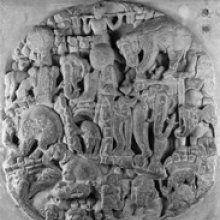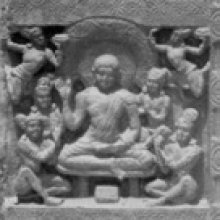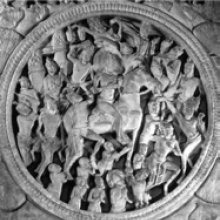Jyotis, Jyoti, Jyotish: 21 definitions
Introduction:
Jyotis means something in Buddhism, Pali, Hinduism, Sanskrit, Hindi, biology, Tamil. If you want to know the exact meaning, history, etymology or English translation of this term then check out the descriptions on this page. Add your comment or reference to a book if you want to contribute to this summary article.
Images (photo gallery)
(+8 more images available)
In Hinduism
Vedanta (school of philosophy)
Source: archive.org: Mandala-brahmana Upanishad of Shukla-YajurvedaJyotis (ज्योतिस्, “spiritual light”) according to the Maṇḍalabrāhmaṇa-upaniṣad.—When one sees jyotis (spiritual light) above his head 12 digits in length, then he attains the state of nectar.
Source: ORA: Amanaska (king of all yogas): (Advaita Vedanta)Jyotis (ज्योतिस्) refers to a “light”, according to the Māṇḍūkyopaniṣatkārikā 3.37.—Accordingly, while discussing the no-mind state: “Devoid of all expression and having transcended all thought, Samādhi is very peaceful, its light perpetually (sakṛj-jyotis) [illuminates], [and it is] immovable and fearless”.

Vedanta (वेदान्त, vedānta) refers to a school of orthodox Hindu philosophy (astika), drawing its subject-matter from the Upanishads. There are a number of sub-schools of Vedanta, however all of them expound on the basic teaching of the ultimate reality (brahman) and liberation (moksha) of the individual soul (atman).
Purana and Itihasa (epic history)
Source: archive.org: Shiva Purana - English Translation1) Jyotis (ज्योतिस्) refers to the “supreme brilliance”, and is used as an epithet of Śiva, according to the Śivapurāṇa 2.2.19. Accordingly as Brahmā narrated to Nārada:—“[...] thus commanded by Śiva in the presence of all, Viṣṇu spoke thus propitiating the great lord:—‘[...] O Śiva, you are the supreme brilliance (jyotis), the firmament, having your own abode. You are the primordial Being, the immovable, the unmanifest, of endless forms, the eternal and devoid of attributes—length etc. From this form alone everything has emanated’”.
2) jyotis (हय) refers to the “planets”, according to the Śivapurāṇa 2.5.8 (“The detailed description of the chariot etc.”).—Accordingly, as Sanatkumāra narrated to Vyāsa: “The divine chariot of lord Śiva consisting of all the worlds was built by Viśvakarman with devoted effort. [...] Goddess Sarasvatī in the form of the Vedas constituted the bells of the bow. The brilliant Viṣṇu became the arrow and Agni the spear-head. O sage, the four Vedas are said to be his horses. The remaining planets (jyotis) became their embellishments [jyotīṃṣi bhūṣaṇaṃ]. His army came up from water. The winds were his feathers, wings etc. Vyāsa and other sages were the drivers of the vehicle. [...]”

The Purana (पुराण, purāṇas) refers to Sanskrit literature preserving ancient India’s vast cultural history, including historical legends, religious ceremonies, various arts and sciences. The eighteen mahapuranas total over 400,000 shlokas (metrical couplets) and date to at least several centuries BCE.
Shaivism (Shaiva philosophy)
Source: SOAS University of London: Protective Rites in the Netra Tantra1) Jyoti (ज्योति) refers to a “bright (sound)”, according to the Netratantra of Kṣemarāja: a Śaiva text from the 9th century in which Śiva (Bhairava) teaches Pārvatī topics such as metaphysics, cosmology, and soteriology.—Accordingly, [verse 2.20-22ab]—“[The Mantrin] should worship the mother of Mantras with the highest bhakti, by spreading flowers and perfume, O Devī. He should extract the deity invoked by the Mantra [with the mantra]. Beginning with the all-pervading and ending with manifold [oṃ], [he should] always [worship with] the nectar of the white flower. The bright sound is highest Śakti (jyoti-dhvani—jyotir dhvaniḥ parāśaktiḥ), [who] resembles one-in-the-same Śiva. By this [worship] the pearls [of the mantra] are all bound in a cord”.
2) Jyotis (ज्योतिस्) refers to “light”.—Accordingly, [verse 2.22cd-28ab]—“[...] That which is described is celebrated in the world as the supreme Amṛta [sa], this is the highest dwelling place. It is the highest Amṛta. Joined with the kalā nectar [visarga], filled with the splendor of the moon. It is the highest abode [of Śiva]. That is the supreme word. That is supreme strength, that is supreme amṛta. The highest of splendors is highest light of light (jyotis—tejo jyotiṣāṃ jyotir uttamam). [...]”.

Shaiva (शैव, śaiva) or Shaivism (śaivism) represents a tradition of Hinduism worshiping Shiva as the supreme being. Closely related to Shaktism, Shaiva literature includes a range of scriptures, including Tantras, while the root of this tradition may be traced back to the ancient Vedas.
Yoga (school of philosophy)
Source: ORA: Amanaska (king of all yogas): A Critical Edition and Annotated Translation by Jason BirchJyotis (ज्योतिस्) refers to the “light (of one’s own self)”, according to the Amanaska Yoga treatise dealing with meditation, absorption, yogic powers and liberation.—Accordingly, as Īśvara says to Vāmadeva: “[...] [Now], I shall define the nature of that highest, mind-free absorption which arises for those devoted to constant practice. [...] By means of an absorption for half a day, the light of his own self (svātma-jyotis) shines. Just like the sun shines forth with its [own] rays of light, the Yogin shines forth [and illuminates] the world. [...]”.

Yoga is originally considered a branch of Hindu philosophy (astika), but both ancient and modern Yoga combine the physical, mental and spiritual. Yoga teaches various physical techniques also known as āsanas (postures), used for various purposes (eg., meditation, contemplation, relaxation).
In Buddhism
Tibetan Buddhism (Vajrayana or tantric Buddhism)
Source: Wisdom Library: Tibetan BuddhismJyotis (ज्योतिस्) is the name of a Tathāgata (Buddha) mentioned as attending the teachings in the 6th century Mañjuśrīmūlakalpa: one of the largest Kriyā Tantras devoted to Mañjuśrī (the Bodhisattva of wisdom) representing an encyclopedia of knowledge primarily concerned with ritualistic elements in Buddhism. The teachings in this text originate from Mañjuśrī and were taught to and by Buddha Śākyamuni in the presence of a large audience (including Jyotis).

Tibetan Buddhism includes schools such as Nyingma, Kadampa, Kagyu and Gelug. Their primary canon of literature is divided in two broad categories: The Kangyur, which consists of Buddha’s words, and the Tengyur, which includes commentaries from various sources. Esotericism and tantra techniques (vajrayāna) are collected indepently.
Biology (plants and animals)
Source: Google Books: CRC World Dictionary (Regional names)Jyotir in India is the name of a plant defined with Cardiospermum halicacabum in various botanical sources. This page contains potential references in Ayurveda, modern medicine, and other folk traditions or local practices It has the synonym Corindum halicacabum Medik.) (Latin halicacabus for a plant called vesicaria (Plinius), Greek halikakabos. (among others).
Example references for further research on medicinal uses or toxicity (see latin names for full list):
· Journal of Ethnobiology and Ethnomedicine (2006)
· Flora Brasiliensis (1897)
· Tentamen Florae Abyssinicae (1847)
· Parasitology Research (2005)
· Journal of Ethnopharmacology (2003)
· Ethnobotany (2007)
If you are looking for specific details regarding Jyotir, for example pregnancy safety, extract dosage, diet and recipes, side effects, health benefits, chemical composition, have a look at these references.

This sections includes definitions from the five kingdoms of living things: Animals, Plants, Fungi, Protists and Monera. It will include both the official binomial nomenclature (scientific names usually in Latin) as well as regional spellings and variants.
Languages of India and abroad
Sanskrit dictionary
Source: DDSA: The practical Sanskrit-English dictionaryJyotis (ज्योतिस्).—n. [dyut-isun āderdasya jaḥ. jyut-isun vā]
1) Light, lustre, brightness, flash; ज्योतिरेकं जगाम (jyotirekaṃ jagāma) Ś.5.3; R.2. 75; Meghadūta 5.
2) Light of Brahman, light regarded as the Supreme spirit; Bhagavadgītā (Bombay) 5.24;13.17; अथ यदतः परो दिवो ज्योतिर्दीप्यते (atha yadataḥ paro divo jyotirdīpyate) Ch. Up.3.13.7; Uttararāmacarita 4.18.
3) Lightning.
4) A heavenly body.
5) A heavenly body, a luminary (planet, star &c.); ज्योतिर्भिरुद्यद्भिरिव त्रियामा (jyotirbhirudyadbhiriva triyāmā) Kumārasambhava 7.21; Bhagavadgītā (Bombay) 1.21; H.1.21; Kumārasambhava 2.19; Ś.7.6.
6) Brightness of the sky, day-light (opp. tamas).
7) The sun and moon (dual).
8) Light as the divine principle of life, intelligence.
9) The science of the course of heavenly bodies; astronomy. See ज्योतिष (jyotiṣa).
1) The faculty of seeing.
11) The celestial world.
12) A Cow; ŚB. on MS.1.3.49. -m.
1) The sun.
2) Fire; ज्योति- ष्कल्पोरुकेशरः (jyoti- ṣkalporukeśaraḥ) (mārutiḥ) Bhaṭṭikāvya 9.6.
8) An epithet of Viṣṇu.
Source: Cologne Digital Sanskrit Dictionaries: Edgerton Buddhist Hybrid Sanskrit DictionaryJyotis (ज्योतिस्).—(1) a kind of flower (query: Trigonella foenum graecum ? so Sanskrit Lex.): jyotir-mālikā- Lalitavistara 11.3 (prose); Tibetan proves that jyotis was understood as a separate name of a flower: me tog (flower) snaṅ ḥod (bright light) daṅ ma li ka daṅ, etc.; (2) name of a (brahman-)youth: Jyotir- māṇavakaṃ (acc.) Śikṣāsamuccaya 167.3, cited from Upāyakauśalya- sūtra.
Source: Cologne Digital Sanskrit Dictionaries: Shabda-Sagara Sanskrit-English DictionaryJyotis (ज्योतिस्).—n.
(-tiḥ) 1. Light. 2. A star. 3. The pupil of the eye. The faculty of seeing. 4. The light regarded as the supreme spirit. 5. The lightening. 6. A heavenly body. m.
(-tiḥ) 1. The sun. 2. Agini or fire. E. dyat to shine, to be or give light isun Unadi affix, and ja substituted for the radical initial.
Source: Cologne Digital Sanskrit Dictionaries: Benfey Sanskrit-English DictionaryJyotis (ज्योतिस्).—i. e. jyut + is, n. Light,
Jyotis (ज्योतिस्).—[neuter] light (l.&[feminine]), brightness, fire, moonshine, light of the eyes; [plural] the heavenly bodies; [dual] sun and moon.
Source: Cologne Digital Sanskrit Dictionaries: Monier-Williams Sanskrit-English DictionaryJyotir (ज्योतिर्):—[from jyut] in [compound] for tis.
Source: Cologne Digital Sanskrit Dictionaries: Monier-Williams Sanskrit-English Dictionary1) Jyotiś (ज्योतिश्):—[from jyut] in [compound] for tis.
2) Jyotiṣ (ज्योतिष्):—[from jyut] in [compound] for tis.
3) Jyotis (ज्योतिस्):—[from jyut] n. light (of the sun, dawn, fire, lightning, etc.; also [plural]), brightness (of the sky), [Ṛg-veda] etc. (trīṇi jyotīṃṣi, light appearing in the 3 worlds, viz. on earth, in the intermediate region, and in the sky or heaven [the last being called uttama, [Vājasaneyi-saṃhitā xx; Atharva-veda xviii]; or uttara, [i, 9, l]; or tṛtīya, [Ṛg-veda x, 56, 1]] [Vājasaneyi-saṃhitā viii, 36; Atharva-veda ix, 5, 8; Mahābhārata iii]; also personified as ‘fire’ on earth, ‘ether or air’ in the intermediate region, and ‘sun’ in the sky, [Śatapatha-brāhmaṇa xi, 5, 8, 2; Śāṅkhāyana-śrauta-sūtra xvi, 21, 2, etc.]; ‘fire, sun and moon’ [Bhagavad-gītā xv, 12])
4) [v.s. ...] fire, flash of lightning, [Meghadūta; Śakuntalā]
5) [v.s. ...] moonlight, [Ṛg-veda iii, 34, 4; Atharva-veda iv, 18, 1]
6) [v.s. ...] ([plural]), [Śatapatha-brāhmaṇa x and; Rāmāyaṇa i, 35, 16]
7) [v.s. ...] eye-light, [Ṛg-veda i, 117, 17]
8) [v.s. ...] the eye, [Mahābhārata i, 6853; Raghuvaṃśa; Bhāgavata-purāṇa ix]
9) [v.s. ...] [dual number] sun and moon, [Gobhila-śrāddha-kalpa iii, 3, 18; Śatruṃjaya-māhātmya i, 28]
10) [v.s. ...] [plural] the heavenly bodies, planets and stars, [Manu-smṛti; Bhagavad-gītā] etc. (tiṣām ayana n. course or movements of the heavenly bodies, science of those movements ([= tiṣa]), [Lāṭyāyana iv, 8, 1; Śikṣā])
11) [v.s. ...] sg. the light of heaven, celestial world, [Ṛg-veda; Vājasaneyi-saṃhitā; Atharva-veda; Śatapatha-brāhmaṇa xiv, 7, 2]
12) [v.s. ...] light as the divine principle of life or source of intelligence, intelligence, [Ṛg-veda vi, 9, 6; Vājasaneyi-saṃhitā xxiv, 3; Atharva-veda xvi; Bhagavad-gītā]
13) [v.s. ...] (pauruṣaj ‘human intelligence’), [Sarvadarśana-saṃgraha]
14) [v.s. ...] (para j, ‘highest light or truth’), [Rāmatāpanīya-upaniṣad] and, [Sarvadarśana-saṃgraha]
15) [v.s. ...] light as the type of freedom or bliss or victory (cf. φάος, φῶς and [Latin] lux), [Ṛg-veda; Atharva-veda; Vājasaneyi-saṃhitā; Śatapatha-brāhmaṇa xiv; Suśruta]
16) [v.s. ...] Name of several Ekāhas, [Taittirīya-saṃhitā vii; Śatapatha-brāhmaṇa xii f.] etc.
17) [v.s. ...] of certain formularies containing the word jyotis, [Lāṭyāyana i, 8, 13]
18) [v.s. ...] a metre of 32 short and 16 long syllables
19) [v.s. ...] = tiṣa, science of the movements of the heavenly bodies, [cf. Lexicographers, esp. such as amarasiṃha, halāyudha, hemacandra, etc.]
20) [v.s. ...] a mystical Name for the letter r, [Rāmatāpanīya-upaniṣad]
21) [v.s. ...] m. fire, [cf. Lexicographers, esp. such as amarasiṃha, halāyudha, hemacandra, etc.]
22) [v.s. ...] the sun, [cf. Lexicographers, esp. such as amarasiṃha, halāyudha, hemacandra, etc.]
23) [v.s. ...] Trigonella foenum graecum, [cf. Lexicographers, esp. such as amarasiṃha, halāyudha, hemacandra, etc.]
24) [v.s. ...] Name of a Marut, [Harivaṃśa 11545]
25) [v.s. ...] of a son of Manu Svārociṣa, 429
26) [v.s. ...] of a Prajā-pati, [Viṣṇu-purāṇa]
27) [v.s. ...] cf. dakṣiṇā-, śukra-, sa-, hiraṇya-, etc.
Source: Cologne Digital Sanskrit Dictionaries: Yates Sanskrit-English DictionaryJyotis (ज्योतिस्):—(tiḥ) 5. n. Light; star; pupil of the eye. m. The sun; fire.
Source: DDSA: Paia-sadda-mahannavo; a comprehensive Prakrit Hindi dictionary (S)Jyotis (ज्योतिस्) in the Sanskrit language is related to the Prakrit word: Joi.
[Sanskrit to German]
Sanskrit, also spelled संस्कृतम् (saṃskṛtam), is an ancient language of India commonly seen as the grandmother of the Indo-European language family (even English!). Closely allied with Prakrit and Pali, Sanskrit is more exhaustive in both grammar and terms and has the most extensive collection of literature in the world, greatly surpassing its sister-languages Greek and Latin.
Hindi dictionary
Source: DDSA: A practical Hindi-English dictionaryJyotish in Hindi refers in English to:—(nf) Astrology; -[vidya/shastra] Astrology..—jyotish (ज्योतिष) is alternatively transliterated as Jyotiṣa.
...
Tamil dictionary
Source: DDSA: University of Madras: Tamil LexiconJyōti (ஜ்யோதி) noun < jyōtis. See சோதி³ [sothi³], 1.
Tamil is an ancient language of India from the Dravidian family spoken by roughly 250 million people mainly in southern India and Sri Lanka.
See also (Relevant definitions)
Starts with (+134): Jyotihsamgraha, Jyotihshastra, Jyotihsutra, Jyotikcandrarka, Jyotiprabhasa, Jyotiranga, Jyotirantargata, Jyotirgana, Jyotirhasta, Jyotiringa, Jyotiringana, Jyotirjna, Jyotirjyotishtoma, Jyotirlinga, Jyotirloka, Jyotirmahavihara, Jyotirmandala, Jyotirmayukha, Jyotirmilin, Jyotirmukha.
Ends with (+52): Adhijyotish, Adityajyotis, Agnijyotis, Antarjyotis, Anyatojyotis, Arunajyotis, Atmajyotis, Bahishtagjyotis, Barhirjyotis, Bhutajyotis, Brahmajyotis, Brihajjyotis, Candrajyotis, Dakshinajyotis, Darshanajyotis, Dashajyotis, Dinajyotis, Divyajyoti, Ekajyotis, Govindajyotis.
Full-text (+283): Jyoti, Dinajyotis, Khajyotis, Tamojyotis, Jyotirvid, Jyotirvidya, Antarjyotis, Jyotishcakra, Jyotiratha, Jyotiringa, Meghajyotis, Jyotishkara, Ubhayatojyotis, Jyotirmaya, Varhirjyotis, Jyotirvija, Padajyotis, Arunajyotis, Jyotirjna, Himajyotis.
Relevant text
Search found 109 books and stories containing Jyotis, Jyoti, Jyotish, Jyōti, Jyotiṣ, Jyotī, Jyotiś, Jyotir, Jyothi, Jyaothi, Jyodi, Jyodhi; (plurals include: Jyotises, Jyotis, Jyotishes, Jyōtis, Jyotiṣs, Jyotīs, Jyotiśs, Jyotirs, Jyothis, Jyaothis, Jyodis, Jyodhis). You can also click to the full overview containing English textual excerpts. Below are direct links for the most relevant articles:
Karmic Astrology—a Study (by Sunita Anant Chavan)
Part 2 - Concept of Jyotiḥśāstra (Introduction) < [Chapter 2 - Jyotiḥśāstra and the Concept of Karman]
Part 2.1.6 - Concept of Brahman and Ātman < [Chapter 2 - Jyotiḥśāstra and the Concept of Karman]
Part 2 - Survey of the Study < [Chapter 1 - Introduction]
Rig Veda (translation and commentary) (by H. H. Wilson)
Sahitya-kaumudi by Baladeva Vidyabhushana (by Gaurapada Dāsa)
Text 7.126 < [Chapter 7 - Literary Faults]
Text 7.15 < [Chapter 7 - Literary Faults]
Introduction < [Introduction]
Mimamsa interpretation of Vedic Injunctions (Vidhi) (by Shreebas Debnath)
Chapter 4.5 - Criteria of a Difference of Rite
Chapter 3 - Utpattividhi (Introduction)
Chapter 10.1 - Conclusion (categories dependent on injunctions)
Thirty minor Upanishads (by K. Narayanasvami Aiyar)
Related products











